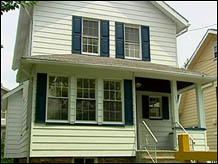1. WASHINGTON, DC - A proposal by the Office of Federal Housing Enterprise Oversight (OFHEO) that could lower the conforming loan limit ("CLL" - calculations establish the maximum size limit for loans that Fannie Mae and Freddie Mac are allowed to purchase and they are also used to set limits for FHA and VA loans - important to home buyers looking to put 3%-5% down with government subsidized loans especially when the subprime market is deteriorating) as early as 2009 and would establish new guidance for calculating the annual limit so that it could be reduced in the future would have adverse consequences for the nation’s home buyers, according to National Association of Home Builders... In NAHB’s response, David Crowe, the association’s senior staff vice president for regulatory and housing policy, noted that the conforming loan limit remained unchanged in 1993 and 1994, years in which the home price index registered declines, because “the current law does not require a decline in the limit when the price index declines.” These declines were subsequently netted out of future increases in the limit. Authority to increase or decrease the conforming loan limit is included in H.R. 1427, The Federal Housing Finance Reform Act of 2007, and NAHB opposes that provision, Crowe said. “Pending enactment of this authority, NAHB maintains that the loan limit can only be increased, but not decreased, under current statutory authority,” he said. View article..
2. NEW YORK - Kimco Realty (KIM - Cramer's Take - Stockpickr - Rating) is third on the list of high-yield stocks with recently raised dividends. The real estate investment trust, which develops and manages shopping centers, pays a yield of 4.3%, having recently increasing its dividend by 11.1%. Kimco has a P/E of 19.3 and a PEG of 1.8. It just reported a 38% increase in funds from operations, a common real estate performance metric that adds back depreciation and other noncash items to net income. Kimco is also on Stockpickr's Dividend Growth portfolio, which lists stocks that raise their dividends on a regular basis.
3. STOCKTON - On Aug. 10, the Krispy Kreme sign on the doughnut shop at March Lane and Interstate 5 might read something like "Krispy Klosed." The Stockton store, which opened to great hoopla and hurrahs in August 2002, will shut down along with other company-owned stores in Fresno, Citrus Heights and Concord. This will mean a Krispy Kreme-less Central Valley. Stores closed in Roseville and Elk Grove last fall and in Modesto before that. Brian Little, director of corporate communications for Winston-Salem, N.C.-based Krispy Kreme Doughnut Corp., also said Krispy Kreme products will no longer be available in local grocery and convenience stores. He said in a statement that the closures are part of the company's "turnaround." View article..
4. CENTRAL VALLEY - (As a father of two children diagnosed with autism related disorders and the continuing challenges that my wife and I face everyday, this article "struck home") Pregnant women from the Central Valley who were exposed to high levels of pesticides were up to six times more likely to give birth to a child with autism or a related disorder, state health officials said Monday. California Department of Public Health researchers studied 465 children with autism spectrum disorders in 19 counties born between 1996 and 1998, comparing them with a control group of nearly 7,000 other children. They found that women who lived close to fields with the highest use of a group of pesticides known as organochlorines were the most likely to bear children with the disorders, which range from mild to severe and cover a wide array of neurological and developmental problems, including difficulties with speaking, social interaction and motor skills. View article..







